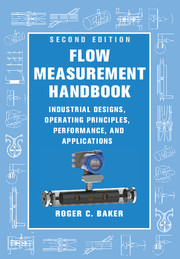Book contents
- Frontmatter
- Dedication
- Contents
- Preface
- Acknowledgements
- Nomenclature
- 1 Introduction
- 2 Fluid Mechanics Essentials
- 3 Specification, Selection and Audit
- 4 Calibration
- 5 Orifice Plate Meters
- 6 Venturi Meter and Standard Nozzles
- 7 Critical Flow Venturi Nozzle
- 8 Other Momentum-Sensing Meters
- 9 Positive Displacement Flowmeters
- 10 Turbine and Related Flowmeters
- 11 Vortex Shedding, Swirl and Fluidic Flowmeters
- 12 Electromagnetic Flowmeters
- 13 Magnetic Resonance Flowmeters
- 14 Ultrasonic Flowmeters
- 15 Acoustic and Sonar Flowmeters
- 16 Mass Flow Measurement Using Multiple Sensors for Single-Phase Flows
- 17 Multiphase Flowmeters 508
- 18 Thermal Flowmeters
- 19 Angular Momentum Devices
- 20 Coriolis Flowmeters
- 21 Probes for Local Velocity Measurement in Liquids and Gases
- 22 Verification and In Situ Methods for Checking Calibration
- 23 Remote Data Access Systems
- 24 Final Considerations
- References
- Main Index
- Flowmeter Index
- Flowmeter Application Index
23 - Remote Data Access Systems
Published online by Cambridge University Press: 05 August 2016
- Frontmatter
- Dedication
- Contents
- Preface
- Acknowledgements
- Nomenclature
- 1 Introduction
- 2 Fluid Mechanics Essentials
- 3 Specification, Selection and Audit
- 4 Calibration
- 5 Orifice Plate Meters
- 6 Venturi Meter and Standard Nozzles
- 7 Critical Flow Venturi Nozzle
- 8 Other Momentum-Sensing Meters
- 9 Positive Displacement Flowmeters
- 10 Turbine and Related Flowmeters
- 11 Vortex Shedding, Swirl and Fluidic Flowmeters
- 12 Electromagnetic Flowmeters
- 13 Magnetic Resonance Flowmeters
- 14 Ultrasonic Flowmeters
- 15 Acoustic and Sonar Flowmeters
- 16 Mass Flow Measurement Using Multiple Sensors for Single-Phase Flows
- 17 Multiphase Flowmeters 508
- 18 Thermal Flowmeters
- 19 Angular Momentum Devices
- 20 Coriolis Flowmeters
- 21 Probes for Local Velocity Measurement in Liquids and Gases
- 22 Verification and In Situ Methods for Checking Calibration
- 23 Remote Data Access Systems
- 24 Final Considerations
- References
- Main Index
- Flowmeter Index
- Flowmeter Application Index
Summary
Introduction
This chapter does not attempt more than a cursory review of this topic, as it is outside the author's main area of expertise, and its existence here is a result of very helpful advice and guidance from Edward Jukes of KROHNE.
This book is about flowmeters which depend, in the main, on mechanical, thermal and/or fluid mechanical effects. One example of mainstream meters, where the signal is electrical throughout, is the electromagnetic meter.
The response of the various meters to flow may then be used to generate an electrical output: milliamp, pulse/frequency and/or digital signal output. Once the electrical output signal is available, we shall need to be able to access it using modern communication methods. This chapter gives a summary of this in an attempt to brief the potential user.
The aim of this book has been to bring together information on the performance of these meters based on theoretical, experimental and industrial experience. I have made the assumption that the electrical signal interpretation, which is based in the meter, is capable of doing the job set by the designer of interpreting the meter output into a standard electrical form. The developments in design of electrical systems are assumed to be such that the reader will not benefit from a detailed description or that the circuit will be changing so fast that any statement will be out of date.
It is now possible to send complete information on parameter values by digital signals which do not need to be converted from a mA value to a flow rate, but provide the flow rate in the required units. In addition the sensor can be addressed, and will respond to questions or commands. The communication has thus become two-way.
Communications technology has been transformed in the past 15 years, to the extent that most of us spend much of our time making use of digital communication devices. This chapter attempts very briefly to indicate how this revolution has affected the instrument communications field.
We have moved from the days when instruments were read at their application sites to the situation where most instruments are read from a computer screen. Remote data access has, therefore, become part of normal procedure in industry.
- Type
- Chapter
- Information
- Flow Measurement HandbookIndustrial Designs, Operating Principles, Performance, and Applications, pp. 625 - 632Publisher: Cambridge University PressPrint publication year: 2016

